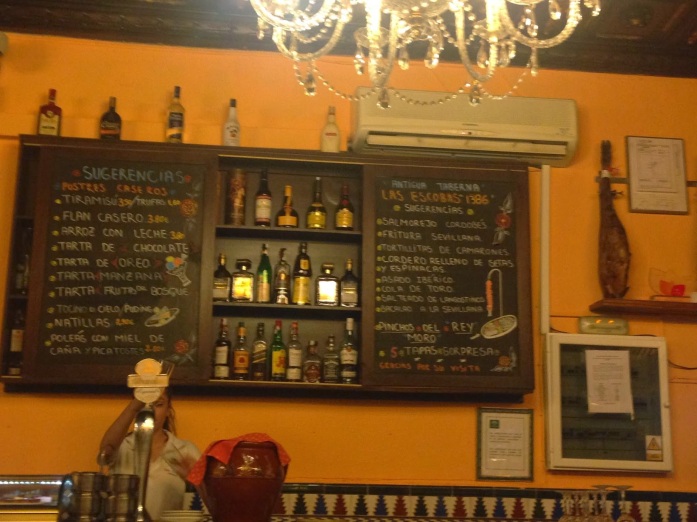Authentic Spanish Cuisines at Antigua Taberna de Las Escobas in Seville Spain
 |
| Photo from http://www.guiadelocio.com/sevilla/restaurantes/sevilla/las-escobas |
Years ago, a wise food guru once told me that to fully grasp the essence of a local delicacy, you must taste it at its very native source.
I agreed with him at the time in deference to his stature, but deep inside, I was disagreeing. There may be some truth in what he said and honestly, it is quite ideal, but it so very impractical. If you follow his reasoning, one must journey to Italia to get an authentic taste of Italian food. One must cross oceans to China, to get authentic dimsum.
I reasoned as well, that an honest to goodness native chef may travel to a foreign land and still cook authentic dishes. I dismissed what he said and went on with my adventures, his words of wisdom put at the recesses of my mind.
But in my most recent trip to Seville, Spain, his words came to me serendipitously.
I was in Seville in September and my colleagues and I were on the hunt for the most authentic Spanish restaurant we can find. We explored the general centro area around Seville Cathedral and stumbled upon Antigua Taberna de Las Escobas.
Since 1386
Compared to other restaurants and dining options along Calle Quintero, this particular restaurant looked positively ancient, medieval even, enticing our group to come in.
Only after spending a few minutes inside the restaurant did we learn that we were in fact dining at the oldest taberna in all of Spain with the restaurant tracing its origins to 1386!!!
Wow, it is even older than Ferdinand Magellan and his subsequent discovery of the Philippines in 1521.
It is so old that its previous patrons included some of the who’s who in Spanish history.
Among the taberna’s regulars was poet, playwright and novelist Miguel de Cervantes de Saavedra, author of the famed Don Quixote. Also a fan of the taberna was fellow poet and playwright Felix Arturo Lope de Vega.
Foreign followers of the place include famous French author Alexandre Dumas and British author Lord Byron.
Though the current interiors of the restaurant may have been refurbished and updated to keep up with the modern times, one can’t help but get that feeling of being somewhere from the old world.
 |
| Tapas Sorpresa |
The lightining was intentionally dimmer, almost sepia, and the furniture intentionally old-fashioned, but definitely built to provide comfort to rich Sevillan customers.
The ceiling was made of old mahogany wood adorned with decors of brass/ or gold-plated lion’s head. The effect really gives one that authentic old Spanish feel.
Authentic Spanish Experience
Now, as I was saying earlier, the words of the wise food guru came to me in a flash as soon as we ordered our food.
Aside from the Spanish flair of the place, the menu served at Las Escobas was truly local.
Being in operation since 1386, Las Escobas has surely perfected the art of cooking authentic Spanish cuisines whether they are tapas or platos.
Las Escobas is famous for its tapas sorpresa or basically tapas of the day. You pay 15 Euros and you can five types of tapas ranging from the usual mushrooms, gambas, to real surprising tapas as sweets, jamon iberico, and salchichon among others.
Tired and hungr y from a day’s worth of endless walking, we ordered two pans of paella de mariscos and had the best tasting paella in all of our stay in Seville and that’s saying something.
Get this: Paella was a Valencian invention which gained popularity in the 1800s. It is therefore not a surprise that Las Escobas, already old by any standards during the 19th century, has also mastered the art of cooking this dish almost synonymous to Spanish gastronomy.
We also ordered Asado Iberico con Setas and several servings of carne pinchos of meat skewers, which brought us to absolute heaven. The meat was well done, which is just the way I like it.
We ordered several other tapas, vino and bebida (beverages).
Aside from the restaurant’s mastery of the Spanish dish, what made that meal truly authentic was the ambiance of the place, the culture and the manner with which the patrons dined in their own corners.
Here in the Philippines, you can have your Spanish dinner at 6;30pm or 7pm and that’s perfectly fine. In Spain, people would still be sleeping or just waking up around those times.
They would head out for dinner at around 9:30pm or 10pm, thus explaining the throngs of people that fill Calle Quintero at that prime hour of 11;30pm.
While having dinner, I was watching from the corners of my eyes, how the locals dine, intent on getting a feel of how it’s like to dine Spanish style.
 |
| Paella de Mariscos |
You can see groups of women or amigas, sharing light meals and bottles of vino, with their perfectly made up faces and regal night outfit.
One man was reading Diario Seville while enjoying his Andalucian gazpacho.
A young couple was holding hands and exchanging passionate kisses at the corner, oblivious to curious onlookers such as I.
Indeed, it was a Spanish dining that was as authentic as it can get.
And i’m very happy that I had the chance to experience and live it even for one night.
 |
| Carne pinchos (skewers) |
 |
| Calle Quintero |





















0 comments:
Post a Comment